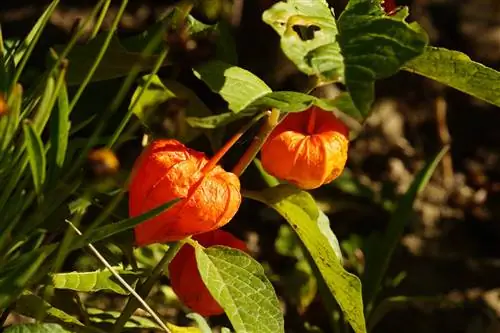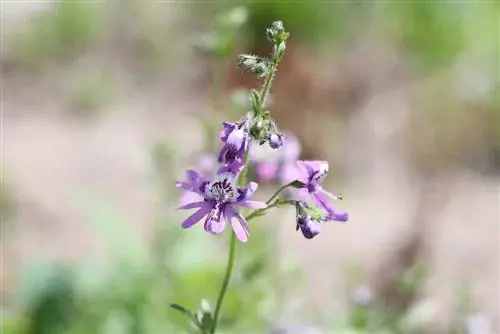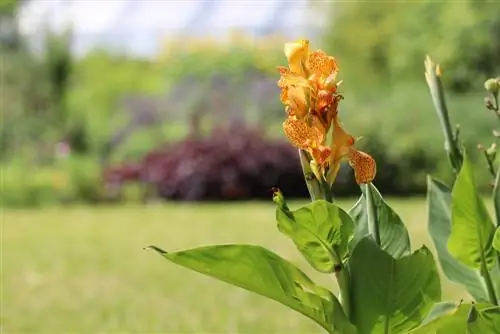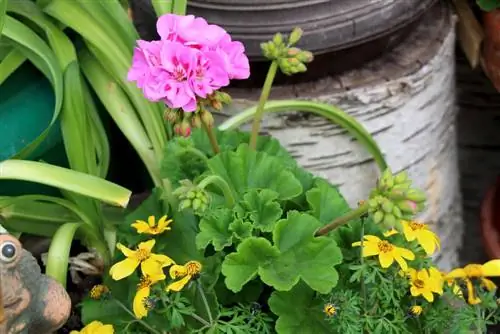- Author admin [email protected].
- Public 2023-12-17 03:39.
- Last modified 2025-01-24 12:45.
The plant, also known as Physalis, is an ornamental plant in our latitudes, even if the berries in the red flowers look similar to the edible Physalis. Lantern flowers are primarily planted in the garden for decoration. Cut branches are often arranged in dry arrangements or in bouquets of flowers. More than 90 varieties are known worldwide in the Physalis family, and the Chinese lantern flower is the most represented in Europe.
It belongs to the Physalis alkekengi family and is also known as:
- Blow cherry
- Jewish cherry
- Andean berry
- Cape Gooseberry
mentioned. The Chinese lantern flower is available as either an annual or a perennial plant. The latter is particularly persistent and grows into a beautiful bush. Heights of more than one meter can be reached. The heart-shaped leaves are widely branched and sit in pairs on the stem. A leaf can reach a length of 10 cm.
Growing the lantern flower
The lantern flower can be made from seeds that can be found in the berries or by purchasing a portion of seeds from a specialist store. Growing indoors can be done early in the year in February. If they are grown from seeds from the fruit, the plants bloom in the first year and then bear fruit. Planting outdoors should definitely take place after May 15th, the so-called Ice Saints. If night frost is still to be expected at this time, it is better to wait a little longer.
- Lantern flowers form runners.
- This means they multiply quickly.
- The flowers come in July/September.
- The fruits ripen in October.
The blooming time of the lantern flower
Depending on the variety, the first flowers appear in May, which can look either yellow or red. These flowers later produce the actual fruit, which is initially hidden in the brightly colored sepals. When these sepals slowly become paler and eventually brown, the fruit inside is ripe and ready to be harvested. It is high in vitamin C and correspondingly acidic. However, you should pay attention to the variety, not all fruits are edible.
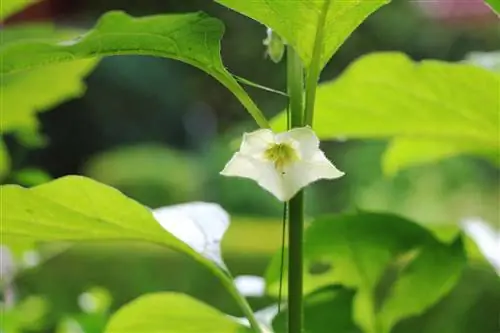
The lantern flower looks very beautiful in a garden bed, where it can also take on the main role. Its colorful fruits and fruit casings make it an eye-catcher; depending on the variety, the berries inside can also be eaten. In late summer or autumn, this flower looks particularly beautiful with asters and other autumn bloomers. Tip: The berries of the lantern flower “Physalis peruviana (Andean berry)” are edible.
Suitable location for lantern flowers
Lantern flowers are a beautiful decoration for the autumn garden. Their bright red or orange calyxes are an attractive contrast to an otherwise uniform green garden in late summer or autumn. It looks particularly beautiful among the other autumn bloomers, chrysanthemums, asters or grasses. The right location for the lantern flower is a sunny spot. When planting, the growth size should be taken into account; half of this width is the planting distance from other flowers. The soil for the lantern flower should be moderately moist; it can tolerate acidic, calcareous or poor soil.
Tip:
The lantern flower is ideal for a wild garden, here it can grow rampant.
Alternatively, the lantern flower can also be kept as a container plant. If the pot is large enough, the flower will receive sufficient nutrients and water. Even as a container plant, it does not need any fertilizer because this would increase leaf growth and reduce fruit production. As a container plant, the lantern flower requires more attention because of sufficient watering. If the lantern flower is in dry soil, it can develop very well and herb-like. If the soil is very nutrient-rich, it produces fewer fruits and more leaves.
Caring for the Chinese lantern flower
When the lantern flower is planted, in addition to the right location and a well-regulated water balance, a layer of mulch should not be forgotten. However, fertilizer applications are not absolutely necessary. This only stimulates leaf growth, but leaves no fruit. If the plants become too large and bulky, the runners through which they multiply should be cut off with a spade. Dividing the runners produces many new young plants!
Tip:
In spring, apply lime to the soil around the lantern flower and loosen it up. If you want to give the lantern flower fertilizer, which is especially the case if it is in a pot, you can use rhododendron fertilizer. Fertilizer also ensures that the leaves become particularly colorful in autumn.
Overwintering the Chinese lantern flower
No special precautions need to be taken to overwinter the Physalis. Since the flower stays alive via rhizomes - i.e. the roots underground - winter cannot harm it. The above-ground parts of the plant can be cut back either in autumn or spring. The plant sprouts new shoots from the rhizomes and then forms a new bush again. Since the rhizomes continue to multiply as runners, one lantern flower quickly becomes a second or even a third.
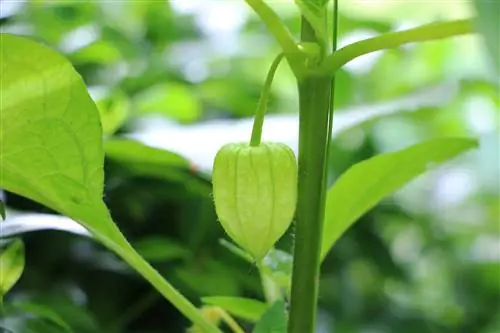
Tip:
Pruning creates beautiful branches for decoration.
Poisonousness of Physalis
Most lantern flowers are planted in the garden by passing them from neighbor to neighbor. It is never clearly clear which variety of lantern flower it is. Therefore, it should not be assumed that the flower contains edible fruits, even if they look very similar to the physalis from the supermarket. Especially if there are children in the household, care should be taken to ensure that they do not touch the flower and, above all, do not eat the fruit in the lanterns.
What you should know about the lantern flower in brief
- The lantern flower belongs to the nightshade family. They are popular perennials because they decorate the garden with their bright orange lanterns in autumn and winter.
- It is often planted in overgrown corners of the garden as it grows very vigorously. So that it doesn't overshoot, you should install root barriers in the ground.
- In small gardens you can also plant them in masonry pots - so as not to have to do without them completely - and bury the pot in the ground up to the top edge. This way the lantern flower stays in one place.
- Unlike the Physalis species known as Andean berries, the Chinese lantern flower (fruits, like other parts of the plant) is poisonous! If you have small children, you may want to avoid the plant at first.
- In early spring, or when the stems have become unsightly, the plants can be cut off close to the ground. In spring they happily sprout again.
- The plant has little demands on soil and location. However, it grows and thrives better in slightly calcareous soil than in other soils.
- It just grows anywhere it can find room to grow. The flowers are white, relatively small and inconspicuous and appear on the plant from May to July.
- Fruit ripening begins in August/September. This is also the time when the lanterns turn a bright orange. The lanterns are very suitable for dry bouquets in autumn or for the vase, but without water.
- If you want to ban the lantern flowers from the garden because they have overgrown everything, you have to make sure that you remove and dig up all root and plant remains. The plant willingly sprouts again from the smallest root.

